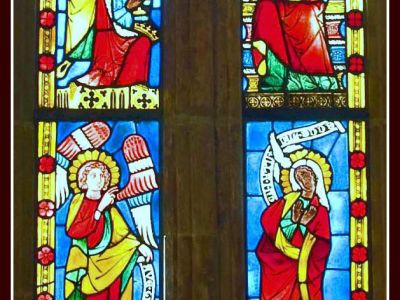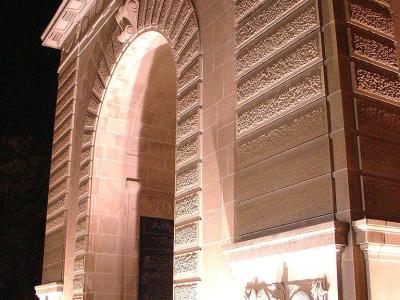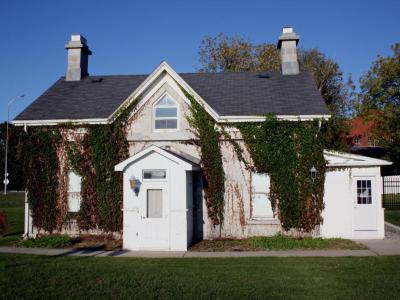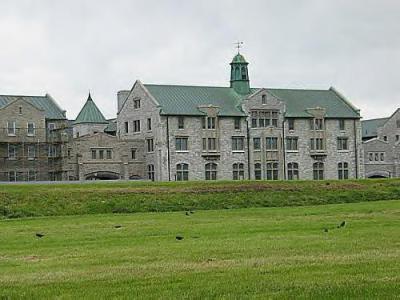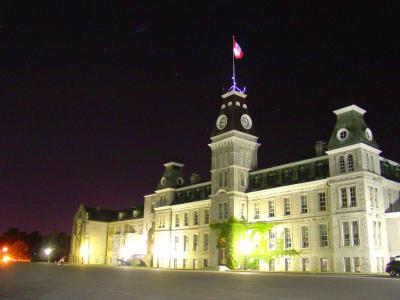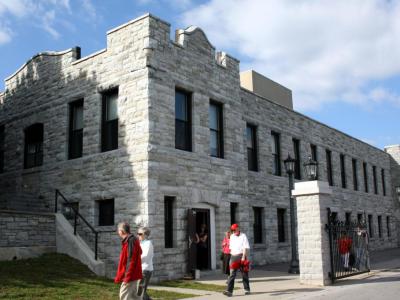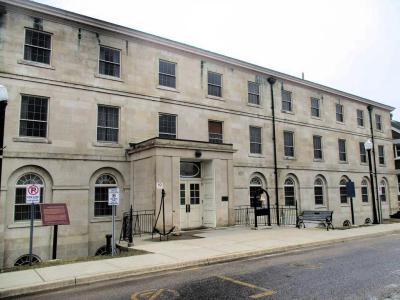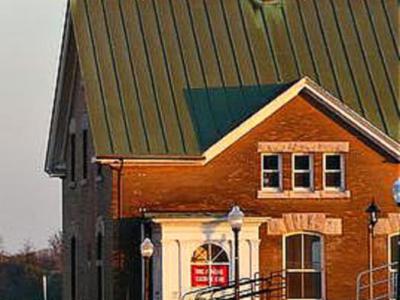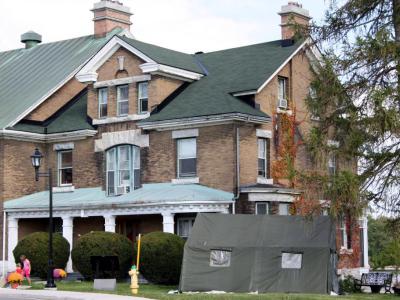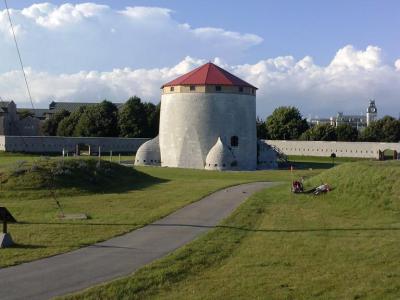Barriefield Heritage Village and Royal Military College Tour (Self Guided), Kingston
Barriefield Heritage Village and the Royal Military College (RMC) in Kingston, Ontario, offer rich insights into Canada’s historical and military heritage. Connected to Kingston via a bridge across the lake, the historic Barriefield Village, established in 1814, is one of Ontario's oldest and most picturesque neighborhoods, designated as a heritage conservation district. The charming area is adorned with well-preserved 19th-century buildings, creating a scenic and historic atmosphere.
Key points of interest include Saint Mark's Anglican Church and the Frontenac County Schools Museum located near Main Street, where visitors can delve into the local educational history. Barriefield Antiques and the Barriefield Rock Garden are also popular spots, offering unique antiques and a peaceful retreat respectively.
Just across the causeway, the Royal Military College stands as Canada's premier military university. Opened in 1876, welcoming its first class of eighteen cadets, known today as the "Old Eighteen", RMC combines academic rigor with military training, preparing officers for leadership in the Canadian Armed Forces.
The campus itself is a blend of historic and modern facilities, including the Memorial Arch, which serves as a poignant reminder of the sacrifices made by RMC graduates. The RMC Guesthouse 1 provides accommodations within this historic setting, and nearby, Yeo Hall Mess Building and MacKenzie Building are central to cadet life. The Former Gun Shed, Stone Frigate Building, and Old Gymnasium further contribute to the college's historic fabric, while Panet House offers administrative services. Notably, the Fort Frederick Martello Tower stands as a historic fortification, offering panoramic views of the surrounding area.
For anyone interested in exploring the depths of Canadian heritage and military history, a visit to Barriefield Heritage Village and the Royal Military College in Kingston is highly recommended. Architecture enthusiasts or those simply looking for a picturesque day out will find in these sites a compelling glimpse into the past and present of Canadian culture.
So, don’t miss the opportunity to experience these iconic locations firsthand. Plan your visit today and discover the rich tapestry of Kingston's history on this self-guided walk!
Key points of interest include Saint Mark's Anglican Church and the Frontenac County Schools Museum located near Main Street, where visitors can delve into the local educational history. Barriefield Antiques and the Barriefield Rock Garden are also popular spots, offering unique antiques and a peaceful retreat respectively.
Just across the causeway, the Royal Military College stands as Canada's premier military university. Opened in 1876, welcoming its first class of eighteen cadets, known today as the "Old Eighteen", RMC combines academic rigor with military training, preparing officers for leadership in the Canadian Armed Forces.
The campus itself is a blend of historic and modern facilities, including the Memorial Arch, which serves as a poignant reminder of the sacrifices made by RMC graduates. The RMC Guesthouse 1 provides accommodations within this historic setting, and nearby, Yeo Hall Mess Building and MacKenzie Building are central to cadet life. The Former Gun Shed, Stone Frigate Building, and Old Gymnasium further contribute to the college's historic fabric, while Panet House offers administrative services. Notably, the Fort Frederick Martello Tower stands as a historic fortification, offering panoramic views of the surrounding area.
For anyone interested in exploring the depths of Canadian heritage and military history, a visit to Barriefield Heritage Village and the Royal Military College in Kingston is highly recommended. Architecture enthusiasts or those simply looking for a picturesque day out will find in these sites a compelling glimpse into the past and present of Canadian culture.
So, don’t miss the opportunity to experience these iconic locations firsthand. Plan your visit today and discover the rich tapestry of Kingston's history on this self-guided walk!
How it works: Download the app "GPSmyCity: Walks in 1K+ Cities" from Apple App Store or Google Play Store to your mobile phone or tablet. The app turns your mobile device into a personal tour guide and its built-in GPS navigation functions guide you from one tour stop to next. The app works offline, so no data plan is needed when traveling abroad.
Barriefield Heritage Village and Royal Military College Tour Map
Guide Name: Barriefield Heritage Village and Royal Military College Tour
Guide Location: Canada » Kingston (See other walking tours in Kingston)
Guide Type: Self-guided Walking Tour (Sightseeing)
# of Attractions: 14
Tour Duration: 2 Hour(s)
Travel Distance: 3.4 Km or 2.1 Miles
Author: vickyc
Sight(s) Featured in This Guide:
Guide Location: Canada » Kingston (See other walking tours in Kingston)
Guide Type: Self-guided Walking Tour (Sightseeing)
# of Attractions: 14
Tour Duration: 2 Hour(s)
Travel Distance: 3.4 Km or 2.1 Miles
Author: vickyc
Sight(s) Featured in This Guide:
- Saint Mark's Anglican Church
- Main Street
- Frontenac County Schools Museum
- Barriefield Antiques
- Barriefield Rock Garden
- Memorial Arch
- RMC Guesthouse 1
- Yeo Hall Mess Building
- MacKenzie Building
- Former Gun Shed
- Stone Frigate Building
- Old Gymnasium
- Panet House
- Fort Frederick Martello Tower
1) Saint Mark's Anglican Church
Saint Mark's Anglican Church stands as a testament to over 150 years of history and community. Situated on a high piece of land, this impressive limestone building is distinguished by its tall, square tower, which commands a striking presence in the landscape. The church was named in honor of John Marks, who generously donated part of his farmland for its construction in 1843. This act of philanthropy laid the foundation for a place of worship that has served its congregation and the wider community for generations.
Inside Saint Mark's, visitors are greeted by the beautiful craftsmanship that defines its interior. The organ chamber, altar, and various pieces of furniture are crafted from dark oak, lending the space a sense of warmth and reverence. These elements, combined with the church's overall architectural design, create a serene and contemplative environment for worship and reflection. The dark oak furnishings are not only functional but also contribute to the church's historic charm and aesthetic appeal.
One of the most striking features of Saint Mark's Anglican Church is its collection of stained glass windows. These windows are renowned for their intricate designs and vibrant colors, which illuminate the interior with a kaleidoscope of light. Each window tells a story, depicting scenes from the Bible and other religious iconography, providing both visual beauty and spiritual inspiration to parishioners and visitors alike.
Inside Saint Mark's, visitors are greeted by the beautiful craftsmanship that defines its interior. The organ chamber, altar, and various pieces of furniture are crafted from dark oak, lending the space a sense of warmth and reverence. These elements, combined with the church's overall architectural design, create a serene and contemplative environment for worship and reflection. The dark oak furnishings are not only functional but also contribute to the church's historic charm and aesthetic appeal.
One of the most striking features of Saint Mark's Anglican Church is its collection of stained glass windows. These windows are renowned for their intricate designs and vibrant colors, which illuminate the interior with a kaleidoscope of light. Each window tells a story, depicting scenes from the Bible and other religious iconography, providing both visual beauty and spiritual inspiration to parishioners and visitors alike.
2) Main Street
Main Street in Barriefield Village serves as the historic transportation route of the village, reflecting its rich heritage and rural charm. In the nineteenth century, this street was bustling with activity as it housed numerous inns, hotels, and shops catering to both residents and travelers.
The architecture along Main Street showcases the village's rural character, with many buildings being one-and-a-half storey homes constructed from wood or stone, adding to the quaint and historical atmosphere of the area.
Among the notable buildings on Main Street is Barriefield House, located at 202 Main Street. This house is believed to be the oldest limestone residence in Barriefield, constructed between 1814 and 1815 by William Baker. Its enduring structure stands as a testament to the early craftsmanship and architectural style that characterized the village during its formative years.
Today, Main Street continues to be a focal point in Barriefield, offering visitors a window into the past and maintaining the village's unique identity and heritage.
The architecture along Main Street showcases the village's rural character, with many buildings being one-and-a-half storey homes constructed from wood or stone, adding to the quaint and historical atmosphere of the area.
Among the notable buildings on Main Street is Barriefield House, located at 202 Main Street. This house is believed to be the oldest limestone residence in Barriefield, constructed between 1814 and 1815 by William Baker. Its enduring structure stands as a testament to the early craftsmanship and architectural style that characterized the village during its formative years.
Today, Main Street continues to be a focal point in Barriefield, offering visitors a window into the past and maintaining the village's unique identity and heritage.
3) Frontenac County Schools Museum
The Frontenac County Schools Museum began as a project to commemorate Kingston’s Tercentenary in 1973. A dedicated group of retired educators spent countless hours researching historical schools, photographing sites, collecting educational books and artifacts, and microfilming hundreds of school records to preserve the rich history of education in the area.
Formally established as a museum association in 1977, the Frontenac County Schools Museum opened to the public in 1979. In 2006, it found a new home in the historic Barriefield Village, where it continues to celebrate the region's educational heritage. Visitors to the museum can step back in time to experience the early 1900s through a meticulously recreated one-room schoolhouse and a display gallery filled with artifacts and archival materials from schools that once dotted Frontenac County.
At the museum, guests can partake in guided gallery tours and hands-on activities such as traditional pen and ink lessons, enhancing their understanding of historical education practices. The museum provides a variety of engaging experiences, including classroom lessons led by a "Schoolmistress" or "Schoolmaster," heritage interpretation through exhibits, and the opportunity to identify artifacts used in pioneer schools. Visitors can also enjoy perusing the books used in early educational settings, offering a comprehensive look at the educational tools and methods of the past.
The Frontenac County Schools Museum is free to the public, though donations are welcome to support its ongoing efforts to preserve and share the history of education in the region.
Formally established as a museum association in 1977, the Frontenac County Schools Museum opened to the public in 1979. In 2006, it found a new home in the historic Barriefield Village, where it continues to celebrate the region's educational heritage. Visitors to the museum can step back in time to experience the early 1900s through a meticulously recreated one-room schoolhouse and a display gallery filled with artifacts and archival materials from schools that once dotted Frontenac County.
At the museum, guests can partake in guided gallery tours and hands-on activities such as traditional pen and ink lessons, enhancing their understanding of historical education practices. The museum provides a variety of engaging experiences, including classroom lessons led by a "Schoolmistress" or "Schoolmaster," heritage interpretation through exhibits, and the opportunity to identify artifacts used in pioneer schools. Visitors can also enjoy perusing the books used in early educational settings, offering a comprehensive look at the educational tools and methods of the past.
The Frontenac County Schools Museum is free to the public, though donations are welcome to support its ongoing efforts to preserve and share the history of education in the region.
4) Barriefield Antiques
Barriefield Antiques is a haven for collectors and enthusiasts, offering a vast selection of high-quality collectibles. This large antique shop is renowned for its diverse inventory, which includes exquisite watches, captivating paintings, elegant ceramics, and beautiful silverware. Each item is carefully curated to ensure the highest standards, making Barriefield Antiques a go-to destination for those seeking unique and timeless treasures.
In addition to its core offerings, Barriefield Antiques boasts a wide array of eclectic items that cater to various tastes and interests. Whether you are searching for a rare piece to complete your collection or simply browsing for a distinctive gift, the shop's extensive selection is sure to delight and inspire. The commitment to quality and variety makes Barriefield Antiques a beloved fixture in the Kingston community, attracting visitors who appreciate the charm and history embodied in each piece.
In addition to its core offerings, Barriefield Antiques boasts a wide array of eclectic items that cater to various tastes and interests. Whether you are searching for a rare piece to complete your collection or simply browsing for a distinctive gift, the shop's extensive selection is sure to delight and inspire. The commitment to quality and variety makes Barriefield Antiques a beloved fixture in the Kingston community, attracting visitors who appreciate the charm and history embodied in each piece.
5) Barriefield Rock Garden
The Bill Robb Barriefield Rock Garden, located in Barriefield Village, is a cherished community project that adds a touch of natural beauty to the area. Established in 1990, the garden runs from the bottom of Main Street alongside James Street to the rock cut along Highway 2. Its creation was spearheaded by Bill Robb, a retired Bell Canada lineman and engineering technician, who meticulously planned and developed the garden using an aerial photograph as his guide.
Bill Robb's vision for the garden was realized with the help of local federal prison inmates, whom he recruited during his volunteer work. These inmates assisted with the gardening efforts and many of them later pursued careers in the landscape industry. This initiative not only beautified the village but also provided valuable skills and opportunities for the participants.
The Barriefield Rock Garden is renowned for its distinctive natural landscaping, which has earned it multiple Kingston Community in Bloom awards. During the Christmas season, the garden becomes even more magical as it is adorned with twinkling lights, thanks to the efforts of Barriefield volunteers. This festive tradition highlights the strong community spirit and the lasting legacy of Bill Robb's dedication to enhancing the local environment.
Bill Robb's vision for the garden was realized with the help of local federal prison inmates, whom he recruited during his volunteer work. These inmates assisted with the gardening efforts and many of them later pursued careers in the landscape industry. This initiative not only beautified the village but also provided valuable skills and opportunities for the participants.
The Barriefield Rock Garden is renowned for its distinctive natural landscaping, which has earned it multiple Kingston Community in Bloom awards. During the Christmas season, the garden becomes even more magical as it is adorned with twinkling lights, thanks to the efforts of Barriefield volunteers. This festive tradition highlights the strong community spirit and the lasting legacy of Bill Robb's dedication to enhancing the local environment.
6) Memorial Arch
The Memorial Arch was built in 1923 and officially unveiled in 1924. This significant monument was dedicated by Mrs. Joshua Wright, the mother of two ex-cadets, Major G.B. Wright and Major J.S. Wright, who lost their lives in the First World War. Constructed from granite and Indiana limestone, the 48-foot-high arch stands gracefully by the water’s edge. Its sides are etched with the names of the battles in which Canada participated during the Great War, evoking a sense of solemn remembrance akin to the Canadian National Vimy Memorial.
The Memorial Arch honors the 170 ex-cadets from the Royal Military College of Canada who made the ultimate sacrifice during World War I out of the 982 who served. The front, or North parapet, of the Arch bears a poignant inscription: "To the Glorious Memory of the Ex-Cadets of the Royal Military College of Canada Who Gave Their Lives for the Empire." The base of the monument is adorned with reliefs depicting ancient Roman war trappings, adding a classical touch to the somber memorial.
In 1949, two granite pylons were added to the Memorial Arch, unveiled by the Governor General of the time, Viscount Alexander of Tunis. These pylons commemorate those who sacrificed their lives between 1926 and 1945 and list the battles in which they fought. The East pylon was further updated in 2006 with a plaque that records the names of ex-cadets who have died in active service since 1945.
The cornerstone of the Memorial Arch was laid by the Governor-General of Canada, His Excellency Viscount Byng of Vimy, during the 1923 Graduation ceremonies. Within the stone, a sealed copper box contains nominal rolls of cadets and staff, pamphlets about the Arch, the RMC Review of May 1923, Canadian coins and stamps, and the Roll of Honour of the College.
The Memorial Arch honors the 170 ex-cadets from the Royal Military College of Canada who made the ultimate sacrifice during World War I out of the 982 who served. The front, or North parapet, of the Arch bears a poignant inscription: "To the Glorious Memory of the Ex-Cadets of the Royal Military College of Canada Who Gave Their Lives for the Empire." The base of the monument is adorned with reliefs depicting ancient Roman war trappings, adding a classical touch to the somber memorial.
In 1949, two granite pylons were added to the Memorial Arch, unveiled by the Governor General of the time, Viscount Alexander of Tunis. These pylons commemorate those who sacrificed their lives between 1926 and 1945 and list the battles in which they fought. The East pylon was further updated in 2006 with a plaque that records the names of ex-cadets who have died in active service since 1945.
The cornerstone of the Memorial Arch was laid by the Governor-General of Canada, His Excellency Viscount Byng of Vimy, during the 1923 Graduation ceremonies. Within the stone, a sealed copper box contains nominal rolls of cadets and staff, pamphlets about the Arch, the RMC Review of May 1923, Canadian coins and stamps, and the Roll of Honour of the College.
7) RMC Guesthouse 1
Royal Military College of Canada (RMC) Building 2, also known as Gatehouse 1, is located within the Point Frederick Buildings National Historic Site. This small stone structure features a gable roof with central gables on both the front and rear, and its main entrance is marked by a fully enclosed entry porch. The building's designation is confined to its footprint, highlighting its historical and architectural significance.
RMC Building 2 is recognized as a Federal Heritage Building due to its historical associations and its architectural and environmental value. It exemplifies early 19th-century vernacular architecture in Ontario, characterized by a center-hall plan and staircase.
The building's craftsmanship is evident in its use of two complementary stone treatments: smooth-dressed ashlar blocks and rough-surfaced random ashlar walls. Additionally, the wooden details in the doors and window treatments further showcase the building's architectural integrity.
RMC Building 2 is recognized as a Federal Heritage Building due to its historical associations and its architectural and environmental value. It exemplifies early 19th-century vernacular architecture in Ontario, characterized by a center-hall plan and staircase.
The building's craftsmanship is evident in its use of two complementary stone treatments: smooth-dressed ashlar blocks and rough-surfaced random ashlar walls. Additionally, the wooden details in the doors and window treatments further showcase the building's architectural integrity.
8) Yeo Hall Mess Building
Yeo Hall Mess Building, also known as Building No. 32, is a prominent structure located on the west border of the parade square. This austere, rectangular building is faced with rusticated limestone, giving it a robust and timeless appearance. The main façade features a distinct shaped, parapeted central gable that rises above a two-storey bay, contributing to its commanding presence. The building's designation is confined to its footprint, emphasizing its historical and architectural significance within the college grounds.
The Yeo Hall Mess Building holds a special place in Canadian military history as it is closely associated with the emergence of a professional armed force through officer training. Constructed during the Great Depression, the building campaign that included Yeo Hall was part of an effort to establish a uniform architectural style at RMC. Despite the general fiscal restraint of the time, this construction effort underscored the importance of military education and the development of a professional military officer corps in Canada.
Architecturally, Yeo Hall Mess Building is an excellent example of the Collegiate Gothic style that became the standard at RMC at the turn of the century. This style is characterized by its axial symmetry, consistency of style and materials, and adherence to Beaux-Arts principles, which emphasize functional efficiency, expandable design, and unity of form. The building's design and craftsmanship reflect the high standards of construction and aesthetic quality that were maintained even during economically challenging times.
The Yeo Hall Mess Building holds a special place in Canadian military history as it is closely associated with the emergence of a professional armed force through officer training. Constructed during the Great Depression, the building campaign that included Yeo Hall was part of an effort to establish a uniform architectural style at RMC. Despite the general fiscal restraint of the time, this construction effort underscored the importance of military education and the development of a professional military officer corps in Canada.
Architecturally, Yeo Hall Mess Building is an excellent example of the Collegiate Gothic style that became the standard at RMC at the turn of the century. This style is characterized by its axial symmetry, consistency of style and materials, and adherence to Beaux-Arts principles, which emphasize functional efficiency, expandable design, and unity of form. The building's design and craftsmanship reflect the high standards of construction and aesthetic quality that were maintained even during economically challenging times.
9) MacKenzie Building
The Mackenzie Building, also known as Building No. 16 or the former Education Block, was erected between 1876 and 1878. This three-storied rectangular edifice exemplifies the Second Empire style, which was prevalent in Canada during the 1870s and 1880s. The building's design features symmetrical pavilion massing, a hallmark of this architectural style. Dominating the structure is a four-storey central tower that houses the main entrance, flanked by five bays on each side. The distinctive roofline, adorned with a copper-clad mansard roof and classically detailed stone chimneys, further accentuates its architectural elegance.
The Mackenzie Building is a Classified Federal Heritage Building, recognized for its historical significance and architectural merit. The Second Empire style, employed here, was a popular choice for educational and institutional structures of the time, chosen for its ability to convey a strong and dignified presence. This style, with its ornate detailing and robust construction, was seen as an appropriate medium for local, state, or federal building commissions aiming to project authority and stability.
The Mackenzie Building is also notable as one of the best surviving works of Thomas Seaton Scott, the Chief Architect of Public Works during its construction. Scott's influence is evident in the building's design, which seamlessly integrates functionality with classical architectural elements. Today, the Mackenzie Building stands as a testament to the architectural and historical legacy of the Royal Military College Kingston, continuing to serve as a symbol of the institution's storied past and enduring significance.
The Mackenzie Building is a Classified Federal Heritage Building, recognized for its historical significance and architectural merit. The Second Empire style, employed here, was a popular choice for educational and institutional structures of the time, chosen for its ability to convey a strong and dignified presence. This style, with its ornate detailing and robust construction, was seen as an appropriate medium for local, state, or federal building commissions aiming to project authority and stability.
The Mackenzie Building is also notable as one of the best surviving works of Thomas Seaton Scott, the Chief Architect of Public Works during its construction. Scott's influence is evident in the building's design, which seamlessly integrates functionality with classical architectural elements. Today, the Mackenzie Building stands as a testament to the architectural and historical legacy of the Royal Military College Kingston, continuing to serve as a symbol of the institution's storied past and enduring significance.
10) Former Gun Shed
Royal Military College of Canada (RMC) Building 24, also known as the Former Gun Shed and the Tailor Shop, stands prominently on the waterfront near the parade square of the RMC campus. This distinctive building features a long, flat roof and is clad in stone, with slightly projecting pavilions that are topped with castellations, including squared-off corners and wave-formed central pediments. The main entrance and the expansive façade are adorned with a carved relief depicting an artillery piece on its carriage, highlighting the building’s military heritage.
RMC Building 24 is a Recognized Federal Heritage Building due to its significant historical associations and its architectural and environmental value. The building is intimately connected with RMC’s role in preparing for the First World War, marking the emergence of a professional armed force in Canada. Constructed amidst growing pre-war tensions in Europe, the building embodies the strategic military planning of the era.
Architecturally, RMC Building 24 is an excellent example of a multi-purpose facility designed for military training exercises. Its design effectively combines functional planning with detailed architectural elements and artistic imagery that evoke military history. The building's iron and steel structure allows for large, open spaces that accommodate both offices and storage areas, demonstrating a very good functional design. The exterior of RMC Building 24 is clad in rusticated stone with smooth stone detailing, showcasing exceptional craftsmanship.
RMC Building 24 is a Recognized Federal Heritage Building due to its significant historical associations and its architectural and environmental value. The building is intimately connected with RMC’s role in preparing for the First World War, marking the emergence of a professional armed force in Canada. Constructed amidst growing pre-war tensions in Europe, the building embodies the strategic military planning of the era.
Architecturally, RMC Building 24 is an excellent example of a multi-purpose facility designed for military training exercises. Its design effectively combines functional planning with detailed architectural elements and artistic imagery that evoke military history. The building's iron and steel structure allows for large, open spaces that accommodate both offices and storage areas, demonstrating a very good functional design. The exterior of RMC Building 24 is clad in rusticated stone with smooth stone detailing, showcasing exceptional craftsmanship.
11) Stone Frigate Building
The Stone Frigate Building is a historic structure located at the Kingston Royal Naval Dockyard. Designed by Archibald Fraser and constructed between 1819 and 1824, the building served as a storehouse under the command of Captain Robert Barrie. It was built to store the gear and rigging of the British fleet dismantled and housed in Navy Bay following the Rush–Bagot Treaty of 1817, which aimed to limit naval armaments on the Great Lakes post-War of 1812.
The dockyard was closed in 1835 but reopened in 1837 during the rebellions in the Canadas. Captain Williams Sandom and a group of sailors took residence in the Stone Frigate warehouse, located near the Saint Lawrence pier in Navy Bay. By the 1860s, the Stone Frigate storehouse and one wharf were the only parts of the dockyard maintained.
In 1876, the Stone Frigate was repurposed when the Royal Military College of Canada was established on the former dockyard site. The former warehouse was converted into dormitories and classrooms, playing a crucial role in the education and accommodation of cadets at the military college. Referred to as "The Boat" within the Royal Military College of Canada, the Stone Frigate accommodates 1 Squadron, who have adopted the name Stone Frigate Military Academy for themselves.
The dockyard was closed in 1835 but reopened in 1837 during the rebellions in the Canadas. Captain Williams Sandom and a group of sailors took residence in the Stone Frigate warehouse, located near the Saint Lawrence pier in Navy Bay. By the 1860s, the Stone Frigate storehouse and one wharf were the only parts of the dockyard maintained.
In 1876, the Stone Frigate was repurposed when the Royal Military College of Canada was established on the former dockyard site. The former warehouse was converted into dormitories and classrooms, playing a crucial role in the education and accommodation of cadets at the military college. Referred to as "The Boat" within the Royal Military College of Canada, the Stone Frigate accommodates 1 Squadron, who have adopted the name Stone Frigate Military Academy for themselves.
12) Old Gymnasium
The Old Gymnasium, also known as Building No. 25, is a significant historical structure located on the east side of the parade square precinct. Facing the athletic field, this long, gable-roofed brick building features large windows and classical details in wood and limestone, embodying a blend of functional design and aesthetic appeal. Its construction marked a pivotal development in the physical training and exhibition programs integral to Canadian military education at the college.
The Old Gymnasium is intrinsically linked to the evolution of RMC, particularly regarding the emphasis on physical training as a core component of military education. The college aimed to produce a "scientific class of officers fit for senior militia appointments" by combining a rigorous academic curriculum with a disciplined athletic program. The establishment of the gymnasium was a critical step in achieving this objective, providing a dedicated space for cadets to engage in physical training and athletic activities, which were considered essential for their overall development and preparedness for military leadership roles.
Architecturally, the Old Gymnasium is valued for its very good aesthetic design, characterized by classical symmetry, balance, and simplicity-elements typical of military architecture. The building's design emphasizes functional efficiency, with its structural system creating an interior column-free space that maximizes utility. The large, regularly spaced windows allow ample natural light to flood the interior, enhancing the suitability of the space for various athletic activities. These design features not only contribute to the building's visual appeal but also reflect the practical considerations necessary for a gymnasium.
The Old Gymnasium is intrinsically linked to the evolution of RMC, particularly regarding the emphasis on physical training as a core component of military education. The college aimed to produce a "scientific class of officers fit for senior militia appointments" by combining a rigorous academic curriculum with a disciplined athletic program. The establishment of the gymnasium was a critical step in achieving this objective, providing a dedicated space for cadets to engage in physical training and athletic activities, which were considered essential for their overall development and preparedness for military leadership roles.
Architecturally, the Old Gymnasium is valued for its very good aesthetic design, characterized by classical symmetry, balance, and simplicity-elements typical of military architecture. The building's design emphasizes functional efficiency, with its structural system creating an interior column-free space that maximizes utility. The large, regularly spaced windows allow ample natural light to flood the interior, enhancing the suitability of the space for various athletic activities. These design features not only contribute to the building's visual appeal but also reflect the practical considerations necessary for a gymnasium.
13) Panet House
Royal Military College of Canada (RMC) Building 27, commonly known as Panet House, is a notable two-storey residential structure situated close to the waterfront on the east side of the RMC campus. Designed in the Classical Revival style, the building is clad in brick with elegant stone and wooden detailing. The gable roof features a prominent front-facing gabled dormer and three rear-facing shed dormers. A broad and deep front porch, which houses the main entrance, adds to the building's stately appearance.
Panet House is historically significant due to its association with the theme of military officer training and the development of a professional armed force in Canada. The building is particularly linked to Major Raymond N.R. Reade, a British officer who was sent to RMC from London in 1901. Major Reade oversaw the construction of several key facilities at RMC, including a gymnasium, a hospital, an electrical plant, and permanent accommodations for the staff-adjutant and his family. This development period was crucial for enhancing the infrastructure necessary for the comprehensive training of military officers.
Architecturally, Panet House is highly valued for its aesthetic design. The Classical Revival style is evident in its symmetrical form and detailed ornamentation, which include masonry and wooden elements showcasing superior craftsmanship. The building's design not only reflects the architectural trends of its time but also connects aesthetically with other structures on the RMC campus and similar defence establishments in the region. Moreover, it shares stylistic elements with contemporary domestic architecture found in eastern Canada, making it a harmonious part of the broader architectural landscape.
Panet House is historically significant due to its association with the theme of military officer training and the development of a professional armed force in Canada. The building is particularly linked to Major Raymond N.R. Reade, a British officer who was sent to RMC from London in 1901. Major Reade oversaw the construction of several key facilities at RMC, including a gymnasium, a hospital, an electrical plant, and permanent accommodations for the staff-adjutant and his family. This development period was crucial for enhancing the infrastructure necessary for the comprehensive training of military officers.
Architecturally, Panet House is highly valued for its aesthetic design. The Classical Revival style is evident in its symmetrical form and detailed ornamentation, which include masonry and wooden elements showcasing superior craftsmanship. The building's design not only reflects the architectural trends of its time but also connects aesthetically with other structures on the RMC campus and similar defence establishments in the region. Moreover, it shares stylistic elements with contemporary domestic architecture found in eastern Canada, making it a harmonious part of the broader architectural landscape.
14) Fort Frederick Martello Tower
The Fort Frederick Martello Tower stands prominently at the tip of Point Frederick. Known as Building 30, this imposing cylindrical stone tower rises to 45 feet at its distinctive trefoil-shaped parapet. Constructed with massive circular walls of rubble masonry, the exterior inclines slightly inward as it ascends, giving it a robust and fortified appearance. The tower features a timber-built, faceted snow roof covered in metal, with shutter-covered, arched embrasures providing access to the interior. At the base, projecting caponiers are elegantly joined to the tower by graceful ogival arches, enhancing the structure's architectural integrity.
The RMC Museum, housed in the Fort Frederick Martello Tower for nearly a century, has curated an extensive collection of art, artifacts, and archives that narrate the rich history of Point Frederick, the Royal Military College, and its community. The museum's origins date back to 1922, when early ex-cadets and their families began donating items to honor the service of their peers and loved ones. After World War I, Lieutenant-General Sir Archibald Cameron Macdonell, the Commandant at the time, initiated the formal collection and display of these objects within the Martello Tower.
During World War II, the museum closed, and its artifacts were placed in storage. It wasn't until 1961 that the museum reopened, resuming its role in preserving and showcasing the college's heritage. Over the years, the museum has grown, with exhibitions now spread throughout the Royal Military College campus, reflecting the institution's evolving history and contributions.
In 2016, significant restoration work began on Fort Frederick, necessitating the museum's relocation from the tower. These restorations are expected to take several years, leaving the museum temporarily without a dedicated public exhibition space. Plans are underway to construct a new museum building, with a temporary exhibit space being established in the interim.
The RMC Museum, housed in the Fort Frederick Martello Tower for nearly a century, has curated an extensive collection of art, artifacts, and archives that narrate the rich history of Point Frederick, the Royal Military College, and its community. The museum's origins date back to 1922, when early ex-cadets and their families began donating items to honor the service of their peers and loved ones. After World War I, Lieutenant-General Sir Archibald Cameron Macdonell, the Commandant at the time, initiated the formal collection and display of these objects within the Martello Tower.
During World War II, the museum closed, and its artifacts were placed in storage. It wasn't until 1961 that the museum reopened, resuming its role in preserving and showcasing the college's heritage. Over the years, the museum has grown, with exhibitions now spread throughout the Royal Military College campus, reflecting the institution's evolving history and contributions.
In 2016, significant restoration work began on Fort Frederick, necessitating the museum's relocation from the tower. These restorations are expected to take several years, leaving the museum temporarily without a dedicated public exhibition space. Plans are underway to construct a new museum building, with a temporary exhibit space being established in the interim.
Walking Tours in Kingston, Ontario
Create Your Own Walk in Kingston
Creating your own self-guided walk in Kingston is easy and fun. Choose the city attractions that you want to see and a walk route map will be created just for you. You can even set your hotel as the start point of the walk.
Kingston Introduction Walking Tour
Kingston, Ontario, known as the "Limestone City" due to its numerous heritage buildings made from local limestone, has a rich history that began with European exploration in the 17th century. The French established a trading post and military fort in 1673 strategically located at the head of the Saint Lawrence River and the mouth of the Cataraqui River that drains into Lake Ontario. This... view more
Tour Duration: 2 Hour(s)
Travel Distance: 3.5 Km or 2.2 Miles
Tour Duration: 2 Hour(s)
Travel Distance: 3.5 Km or 2.2 Miles
The Most Popular Cities
/ view all



